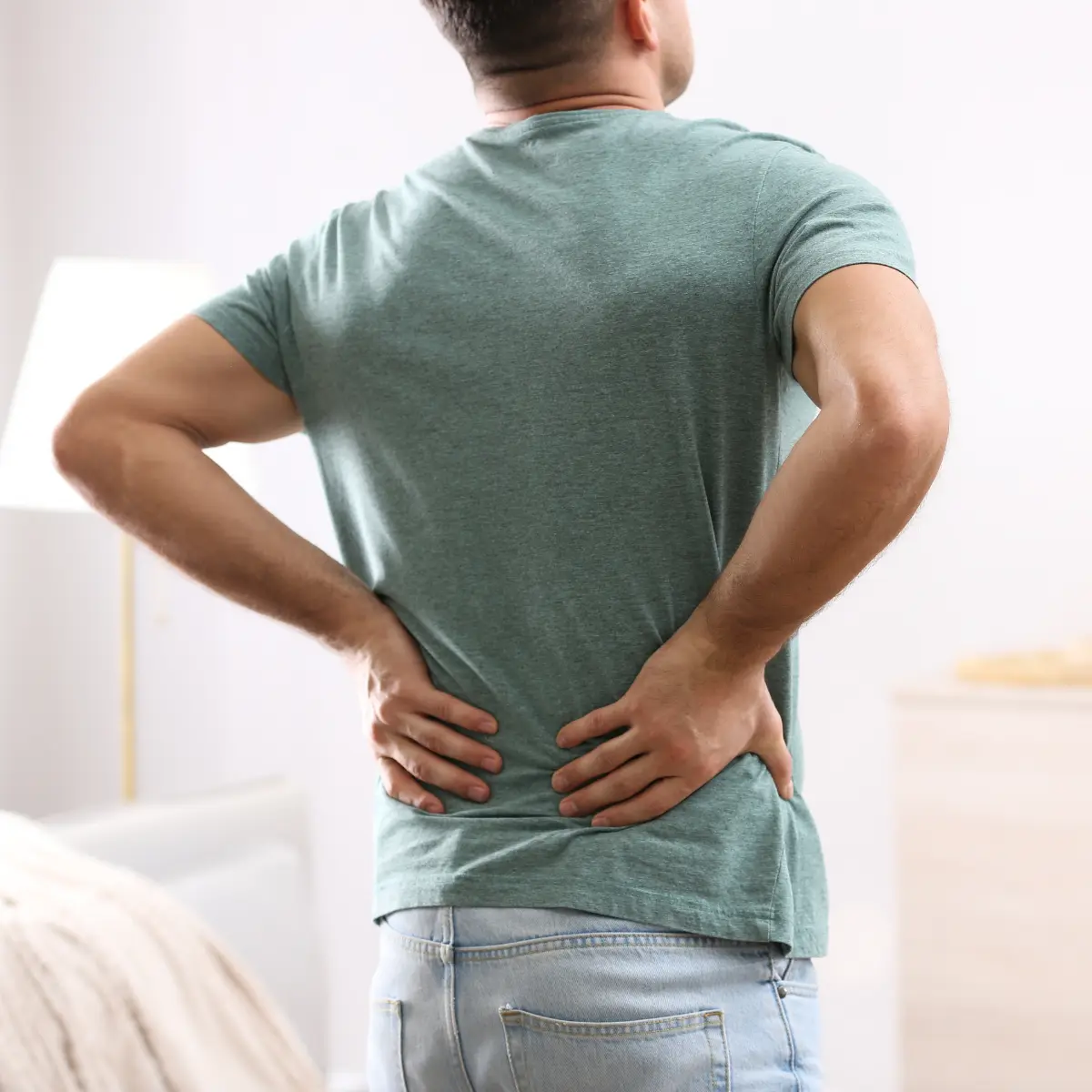Comprehensive Solutions for Lower Back Pain: Tailored Treatment Plans
Don’t let lower back pain hinder your workouts. Our pain management experts are here to provide you with comprehensive solutions for lasting relief. We’ll work closely with you to develop tailored treatment plans that address your specific needs. During your visit, our specialists will assess the causes of your lower back pain and develop a treatment plan that is customized to your unique situation. We’ll provide you with effective techniques and strategies to alleviate your pain and help you exercise without discomfort. Lower back pain, a widespread and often debilitating condition, affects millions of individuals worldwide.
The prevalence of lower back pain is on the rise, attributed to various factors, including sedentary lifestyles, poor ergonomics, and the aging population. For those who suffer from lower back pain, the impact on their daily lives can be significant, affecting mobility, work, and overall well-being. Fortunately, there are comprehensive solutions available to address this condition. Tailored treatment plans, personalized to the individual’s unique needs and condition, are at the forefront of lower back pain management. In this in-depth exploration, we will delve into the complexity of lower back pain, its causes, diagnosis, and the various elements that comprise tailored treatment plans to provide comprehensive solutions for those seeking relief from this common and often troublesome condition.
Navigating the Complexity of Lower Back Pain: Types, Causes, and Treatment Approaches
Lower back pain is a multifaceted condition that often stems from a combination of factors, making it a challenging ailment to pinpoint precisely. It can manifest in various forms, ranging from acute and short-lived episodes to chronic and persistent discomfort. Understanding the complexity of lower back pain is crucial for devising effective treatment plans. There are two primary types of lower back pain: acute and chronic. Acute lower back pain typically results from sudden injuries, strains, or sprains.
These episodes often bring about intense pain, and they are generally short-lived, lasting from a few days to a few weeks. Conversely, chronic lower back pain endures for an extended period, often defined as lasting for more than three months. This type of pain can be attributed to underlying medical conditions, structural issues, or a combination of factors, making it a more persistent and often complex issue to address.

Common causes of lower back pain include muscle strains, which can occur due to overexertion, sudden movements, or improper lifting techniques. Herniated discs, or bulging discs, can exert pressure on nearby nerves, leading to radiating pain, numbness, or tingling in the legs or buttocks. Degenerative disc disease, often associated with aging, results from the wearing down of the intervertebral discs between the vertebrae, causing pain and reduced mobility. Spinal stenosis, marked by the narrowing of the spinal canal, can compress the spinal cord and nerves, leading to pain and limited mobility.
Various forms of arthritis, including osteoarthritis and rheumatoid arthritis, can affect the joints in the spine, causing pain and stiffness in the lower back. Structural issues, such as scoliosis, involving an abnormal curvature of the spine, can lead to chronic lower back pain. Poor posture and ergonomics, whether when sitting or working, can place excessive strain on the lower back. A sedentary lifestyle with little physical activity and prolonged periods of sitting can weaken the muscles supporting the lower back, contributing to discomfort. Finally, carrying excess weight places additional stress on the lower back, exacerbating pain.
Recognizing these various factors and their role in lower back pain is instrumental in the development of effective treatment and prevention strategies. When dealing with lower back pain, understanding the type of pain and its underlying causes is essential to create personalized treatment and exercise plans that address the specific condition and limitations of the individual. Effective management of lower back pain relies on the development of tailored treatment plans that acknowledge the uniqueness of each individual’s condition. A one-size-fits-all approach is often inadequate, given the considerable variation in lower back pain experiences.
Tailored treatment plans, designed after conducting a comprehensive assessment of the patient’s specific needs and condition, offer a more effective and holistic approach to lower back pain management. These plans typically incorporate the following elements: The cornerstone of a tailored treatment plan is a thorough evaluation and diagnosis. This process encompasses a detailed medical history, a comprehensive physical examination, and, in some instances, diagnostic imaging like X-rays or MRI scans. Accurate diagnosis is essential for pinpointing the root causes of lower back pain, paving the way for effective treatment strategies.
Comprehensive Care Strategies: Collaborating with Pain Management Specialists for Effective Relief
Collaboration with pain management specialists is a vital component of tailored treatment plans. These specialists possess specialized training and expertise in assessing, diagnosing, and treating various pain conditions, including lower back pain. Medication management is another facet of tailored treatment plans. Pain management specialists can prescribe suitable medications when needed to effectively manage pain. They also oversee the proper use of medications and monitor for potential side effects.
Physical therapy often plays a central role in tailored treatment plans. Physical therapists, experts in addressing musculoskeletal conditions, can provide targeted exercises and rehabilitation to enhance lower back strength and flexibility. For individuals with severe or chronic lower back pain, tailored treatment plans may include interventional procedures performed by pain management specialists. These procedures, such as epidural injections, facet joint injections, or nerve blocks, aim to alleviate pain and improve mobility.
Customized exercise and rehabilitation regimens are commonly incorporated into tailored treatment plans. These exercises are designed to bolster the lower back and core muscles, enhance flexibility, and improve overall spinal health. Addressing poor posture and ergonomics is a vital aspect of lower back pain management. Tailored treatment plans may offer guidance on maintaining good posture and optimizing workspace ergonomics to prevent exacerbation of the condition.

Holistic Approach to Lower Back Pain: Integrating Weight Management, Emotional Support, and Long-Term Care
Weight management is crucial for individuals seeking to manage lower back pain. Excess weight places additional stress on the spine, and tailored treatment plans may involve nutritional guidance and weight management strategies. The psychological and emotional impact of chronic pain conditions, including lower back pain, is acknowledged in tailored treatment plans.
These plans often integrate psychological support, such as counseling or cognitive-behavioral therapy, to address the emotional facets of pain. Lower back pain can be a long-term issue, and tailored treatment plans are designed to provide ongoing monitoring and adjustments to the treatment approach as needed. This ensures that patients receive continuous support and care in their journey toward relief and better spinal health.
Lower back pain management is most effective when approached collaboratively. A multidisciplinary team of healthcare professionals, including pain management specialists, physical therapists, and, in some cases, surgeons, work together to provide a holistic and patient-centered approach to care. This collaborative approach ensures that the patient receives comprehensive and well-rounded treatment, addressing both the physical and emotional aspects of lower back pain. This collaborative approach begins with an accurate diagnosis, where pain management specialists, often in collaboration with radiologists and other specialists, are responsible for pinpointing the underlying causes of lower back pain.
Through detailed examination, including imaging studies and additional tests when necessary, an accurate diagnosis is established. Once the diagnosis is confirmed, the collaborative team, led by pain management specialists, devises a tailored treatment plan that takes into account the patient’s specific condition, limitations, and goals. This treatment plan may involve various elements, including medication management. Pain management specialists prescribe and oversee medications as part of the treatment, ensuring that they are suitable and safe for the patient.
They work closely with pharmacists to guarantee the appropriate use of medications. Physical therapists play an indispensable role in this collaborative effort, providing expert guidance and support in the development of exercise and rehabilitation regimens. Their work complements the treatment plans created by pain management specialists, resulting in targeted care that addresses the patient’s needs.
In cases where interventional procedures are deemed necessary for pain relief, pain management specialists perform these procedures in collaboration with anesthesiologists or radiologists, assuring the patient’s comfort and safety throughout the process. Furthermore, specialists in ergonomics and occupational therapy also contribute to the collaborative effort. They assess and improve the workspace ergonomics and posture of patients, which can significantly reduce the risk of worsening their lower back pain.
Emotional and psychological support is another essential component of the collaborative approach. Psychologists or therapists are part of the team, helping patients cope with the emotional challenges that often accompany chronic pain. This support is particularly important in addressing the mental toll of lower back pain. Additionally, nutritionists or dietitians may be part of the team to assist patients with weight management and ensure that their nutritional needs are properly met. Weight management is integral to the holistic approach of lower back pain treatment, as excess weight can exacerbate pain and strain on the lower back.
The collaborative approach to lower back pain management offers patients the advantage of a comprehensive and well-rounded treatment plan. This model ensures that patients not only receive care tailored to their specific condition but also addresses the emotional and psychological aspects of living with chronic pain. The collaboration of specialists from various fields results in a more effective and patient-centered approach to addressing lower back pain.
A patient-centered approach is fundamental to the success of tailored treatment plans for lower back pain. In this model of care, the patient’s preferences, values, and goals significantly influence the development of the treatment plan. Patients are active participants in their healthcare decisions, and their input is highly valued. Patient-centered care fosters a strong partnership between patients and healthcare providers.
Conclusion
It empowers patients to make informed decisions about their treatment, engage in their pain management, and ultimately achieve better treatment outcomes. Lower back pain is a complex and persistent issue, and its management requires ongoing attention. Patients may experience episodic flare-ups or require long-term care to manage their condition effectively. The collaborative and patient-centered approach, in combination with tailored treatment plans, is essential for addressing this ongoing challenge comprehensively.
By recognizing the unique needs and characteristics of each individual in their care, healthcare providers can ensure the best possible outcomes and the well-being of patients. Tailored treatment plans, supported by a multidisciplinary team, empower individuals to take control of their lower back pain and move toward a life free of discomfort and limitations. Ready to elevate your understanding of back pain? Dive into our article exploring the nuances of back pain during exercise for a holistic approach to a healthier, pain-free back.

